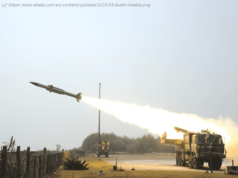And quite possibly useless.
When it was announced President Trump would speak to the nation regarding military action in Syria on Friday night, there was reason to think that he might say something truly surprising — and truly frightening. A recent Wall Street Journal report had detailed how Trump, who just days ago had expressed his desire to pull all U. S. troops out of Syria, was now eager to punish Russia and Iran in the aftermath of a chemical-weapons attack perpetrated by Bashar al-Assad.
But Trump appears to have taken seriously the counsel of his generals, who had advocated a much more limited approach. In the end, the airstrikes he ordered were among the most conventional actions he’s taken as president. The strikes were quite likely unconstitutional, as a smattering of Democrats and Republicans protested, justified based on an authorization of force from 2001 that pretty clearly doesn’t encompass the Syrian civil war. And they reflect a foreign-policy apparatus that too often wants to do something, even if that something makes little moral or tactical sense — an ethos perfectly reflected in a tweet from prominent Hillary Clinton ally Anne-Marie Slaughter:
But ineffectual military action in the Middle East has become a grand American tradition, and it was easy to imagine most recent presidents — save Trump’s immediate predecessor — following a similar, middle-of-the-road path.
The United States, which was joined by Britain and France in its mission, took special care not to aim its attack near Russian troops, the kind of provocation that people who would like to avoid World War III were particularly anxious about
So what exactly did it do? The Pentagon said it had launched more than 100 Tomahawk missiles at three chemical weapons and storage facilities near Damascus, the Syrian capital, and Homs, another major city.
Lieutenant General Kenneth McKenzie said that the missiles had struck at the “heart” of key facilities.
“They lost a lot of equipment. They lost a lot of material, and that’s going to have a significant effect,” he said.
The strike was surely more effective than last year’s almost perfunctory “pinprick” attack on a Syrian airfield, which had no perceptible impact on Assad’s operational capabilities. But while more targets were hit and more missiles fired this time around, it won’t alter the fundamental dynamics of the grinding, seven-year-long conflict, which has left hundreds of thousands dead, almost all as a result of nonchemical weapons of war.
The Assad regime is projecting an image of defiance. The Syrian army claimed that “Syrian Air Defense systems confronted, with high competence, the missiles of the aggression and shot down most of them,” a claim the U. S. rejected. The overall mood in Damascus was relief that the strikes weren’t larger in scope.
On Saturday, American officials talked tough anyway.
“I spoke to the president this morning, and he said, ‘If the Syrian regime uses this poisonous gas again, the United States is locked and loaded,’” said Nikki Haley, the U. S. Ambassador to the United Nations.
“When our president draws a red line, our president enforces the red line,” she added, in a dig at President Obama.
Obama famously failed to enforce his zero-tolerance policy for Syrian chemical weapons with force, choosing instead to cut a deal with Russia that would destroy all of the munitions instead. As we’ve seen in recent years, that strategy proved ineffective.
But Haley’s point is also a reminder that Syria has already made Trump look weak. His last airstrike clearly didn’t stop the Assad regime from carrying out more chemical-weapons attacks over the past year. And Syria has a reason to flout international law in this way; last weekend’s barbaric attack achieved its desired effect, forcing recalcitrant rebels to give up an important piece of territory. For Assad, the incentive to notch incremental victories has, so far, been stronger than the disincentive to incur America’s wrath. Will Friday’s relatively weak showing do much to change that equation? And are we to believe that the chemical weapons that were thought to have been destroyed once and for all years ago are now, at last, gone for good?
As ever in the Middle East, the U. S. finds itself with no good options. If it wants to definitely wipe out Assad’s chemical-weapons capabilities, it risks becoming further embroiled in an already intractable quagmire, or worse, provoking a clash between world powers. If it doesn’t, it is merely showing itself to be toothless, an option that, as President Obama learned, involves some loss of face but little in the way of World War risk.
If Assad launches another chemical attack — a very plausible scenario — it’s easy to imagine Trump going big on the first option. In the meantime, the people of Syria continue to suffer through an endless war, as the United States all but closes its doors to them.






